This recipe will give you deliciously light and fluffy homemade doughnuts. Roll them in sugar, dip them in vanilla glaze or stuff them with jam or custard!
You can’t beat an old fashioned yeasted doughnut. They are much easier to make than you think – you just need to give the dough plenty of time to rise!
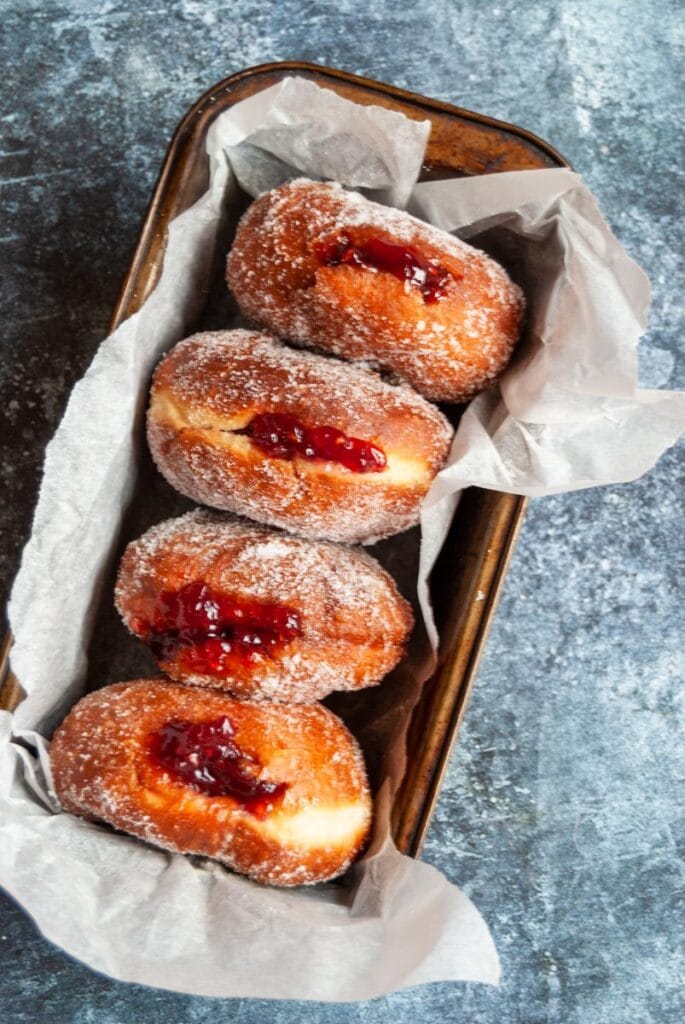
As much as I love a baked doughnut such as my blood orange baked doughnuts, there are times when only a proper sugar crusted fried doughnut will hit the spot. I also use this basic fried doughnut recipe to make cream filled Biscoff doughnuts!
Yes, they are time consuming to make – but they are great for a rainy weekend baking project. Your family and friends will definitely thank you for your efforts!
Apart from baking cakes, baking with yeast is one of my favourite baking activities. If you’re looking for more recipes that use sweet bread dough, check out my cinnamon rolls, pumpkin cinnamon rolls, cinnamon pecan monkey bread, chelsea buns and mocha swirl sticky buns.
You could keep the doughnuts plain and simple – just rolled in cinnamon or plain sugar – but I really love an oozing jam centre. Every now and then, it’s 100% WORTH the calories.
Custard is also a very popular doughnut filling in my house. I’ve used this custard doughnut filling recipe in the past with great success.

HOW TO MAKE homemade DOUGHNUTS
This is a yeasted doughnut recipe. I always use the fast action instant yeast that comes in little sachets. You will need two 7g packets to make this recipe. You will also need strong white bread flour.
I always use my kitchen mixer fitted with a dough hook to make yeasted dough. You could make the dough by hand, but I won’t lie – it’s hard work on the old arm muscles!
You’ll need a deep fat fryer filled with a flavourless oil such as vegetable or sunflower oil. I have used a large saucepan with a sugar thermometer in the past, but a deep fat fryer is a bit safer!
Take a piece of the dough and fold it over itself a few times until it begins to “tighten” Cradle the dough in your hand and lightly roll you should have a smooth, tight ball of dough Leave to rise on an oiled baking tray Fry the doughnuts at 160C for 2-3 minutes on each side
Temperature for frying doughnuts
The ideal temperature for frying doughnuts is 150/160C. It’s important to keep the oil at around this temperature all the time – if it drops any lower than 150C/320F, the doughnuts will absorb more oil and will be greasy.
I have tried to cook doughnuts at 170/180C, but the doughnuts turned very brown immediately and they were raw in the middle. Once I took it down to around 160C, the doughnuts were perfect – light golden on the outside and fluffy in the middle.
Either way, please be extra careful when cooking with extremely hot oil. I wouldn’t recommend getting the kids to help with this recipe. Please read this guide on how to deep fry safely before you begin.
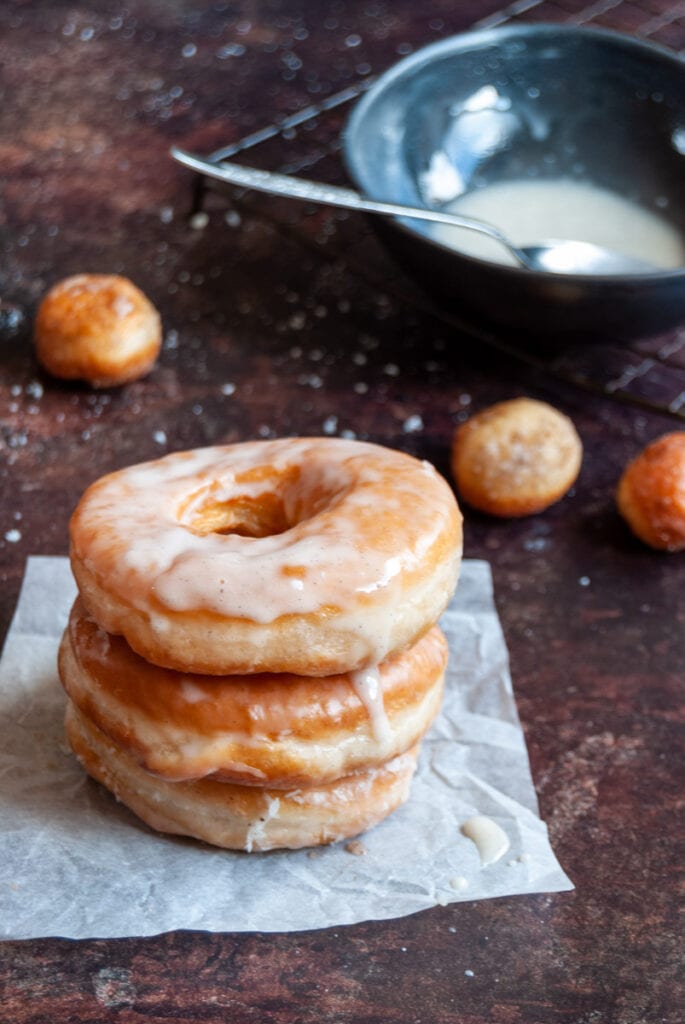
HOW TO make filled DOUGHNUTS
I love a filled doughnut! My favourite filings are classic jam, lemon curd or custard.
To fill the doughnuts, I find it easiest to use a piping bag fitted with a nozzle with a diameter of about 1 inch. Using a sharp knife, make a little hole in the side of the cooled doughnut. Insert the nozzle into the hole and fill with the jam until it reaches the top. This is a very satisfying job, trust me.
You should aim to get about 2 tablespoons worth of jam or custard in each doughnut.
Drain the cooked doughnuts on kitchen towel for a couple of minutes before coating in the sugar – don’t transfer them straight from the fryer to the sugar – this will make the sugar clump up and turn greasy.
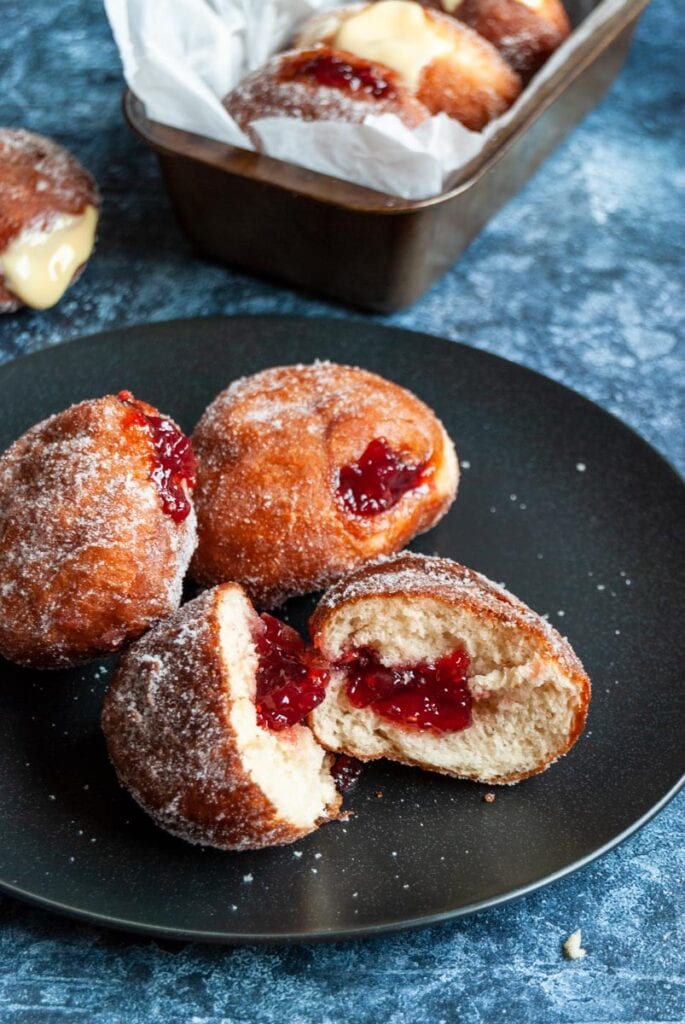
how to make ring (glazed) doughnuts
- Flour a work surface and using a rolling pin, roll out the dough into a large round approximately the thickness of two pound coins. Using a 4 inch round floured cutter, cut out rounds of dough. I keep a bowl of flour beside me and dip the cutter in it each time I cut out a round – it helps with sticking.
- Using a 1 1/2 inch round cutter, cut out the middle of each round but don’t discard them.
- Place the rounds of dough on two large oiled baking trays, leaving plenty space between them because they will double in size. Place the holes on a smaller oiled tray.
- Cover the trays with oiled cling film or large proving bags and leave to prove for 40 minutes to an hour, or until doubled in size.
Roll out the dough on a floured work surface Cut out rounds of dough Cut out the middle of each round using a small cutter (I used the bottom of a piping nozzle) Leave to prove until almost doubled in size
- Follow the instructions in the recipe card for frying the doughnuts. Drain them on kitchen paper for a few minutes before placing on a wire rack to cool down slightly.
- Dip the doughnuts in vanilla glaze while they are still warm (see recipe card below for vanilla glaze recipe).
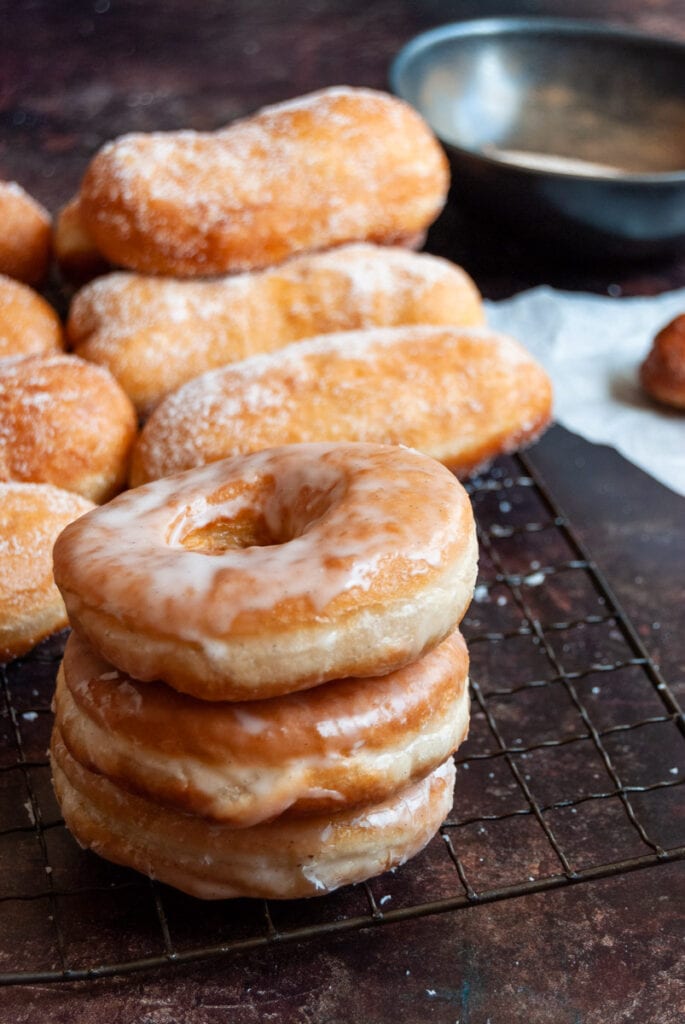
how to make finger doughnuts
- For finger doughnuts, roll the dough into balls then roll them into long finger shapes, about 7 inches long. They will probably shrink back slightly, but don’t worry too much about it.
- Place on two or three large oiled baking trays, leaving some space between them to allow for spreading. Cover the trays with oiled cling film or large proving bags and leave for 40 minutes to an hour or until doubled in size.
proving the doughnuts until almost doubled in size fry for 3-4 minutes on each side Drain on kitchen paper for a few minutes before lightly coating in sugar
- Fry the doughuts for 3-4 minutes per side until light golden and crisp. Drain on kitchen paper for a few minutes before lightly coating in caster sugar. Transfer the doughnuts to a wire rack to cool completely.
- My favourite filling for finger doughnuts is lightly whipped vanilla cream, sliced strawberries and strawberry sauce. I used the same strawberry tart jelly I use in my strawberry tart recipe. Of course, you can fill them with whatever you like – there are endless possibilities!
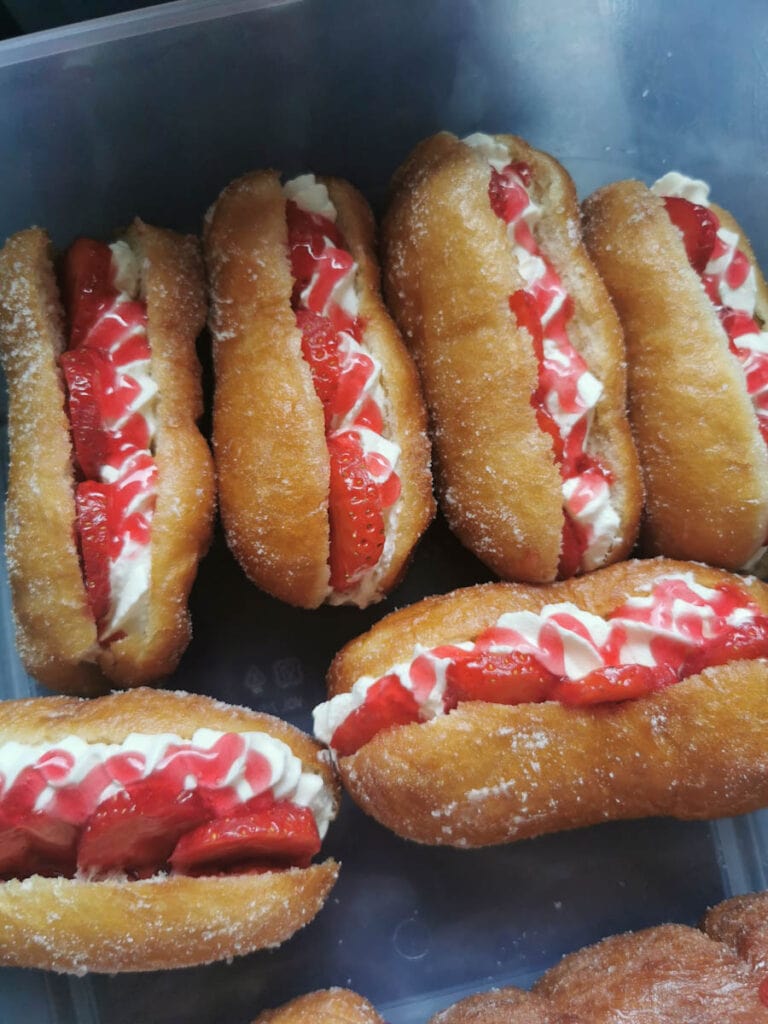
how to make Doughnut holes
- If you’re making ring doughnuts, don’t throw away the little holes you’ve cut out! That would be criminal. Fry them, toss them in cinnamon sugar or vanilla glaze and eat. Cook’s treat!
- Prove the doughnut holes on an oiled baking tray. Fry the holes for about 2 minutes per side (see recipe card for full instructions), drain on kitchen towel for a few minutes before tossing in cinnamon sugar or dipping in vanilla glaze.
- To make the cinnamon sugar, stir together 1 tablespoon of white sugar and 1 teaspoon of ground cinnamon.
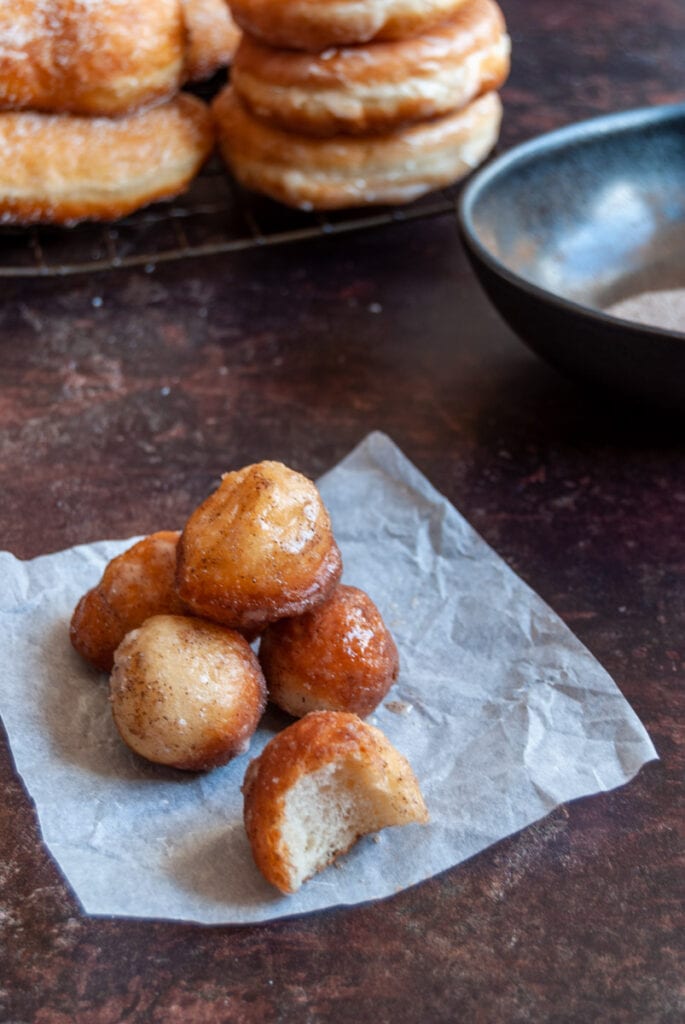
how long do fresh homemade doughnuts last?
Yeasted doughnuts are best eaten fresh on the day they are made. Of course, they won’t keep as long as shop bought doughnuts because they have no additives!
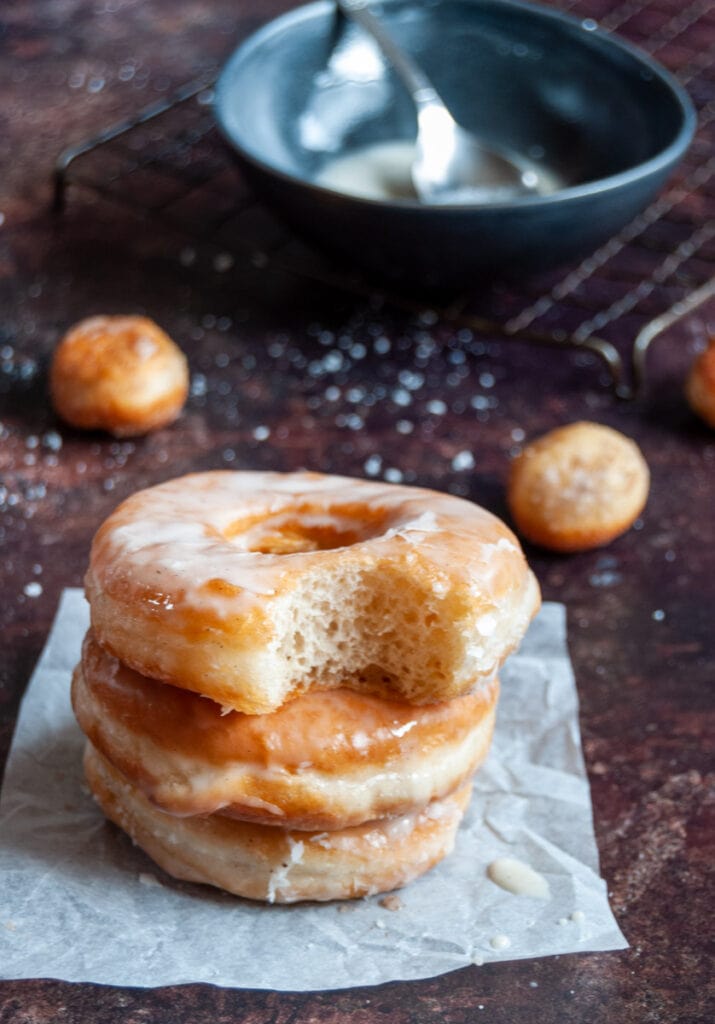
Did you make this recipe?
I really hope you loved it! Let me know what you thought by leaving a comment below and rate the recipe out of five by clicking on the stars in the recipe card.

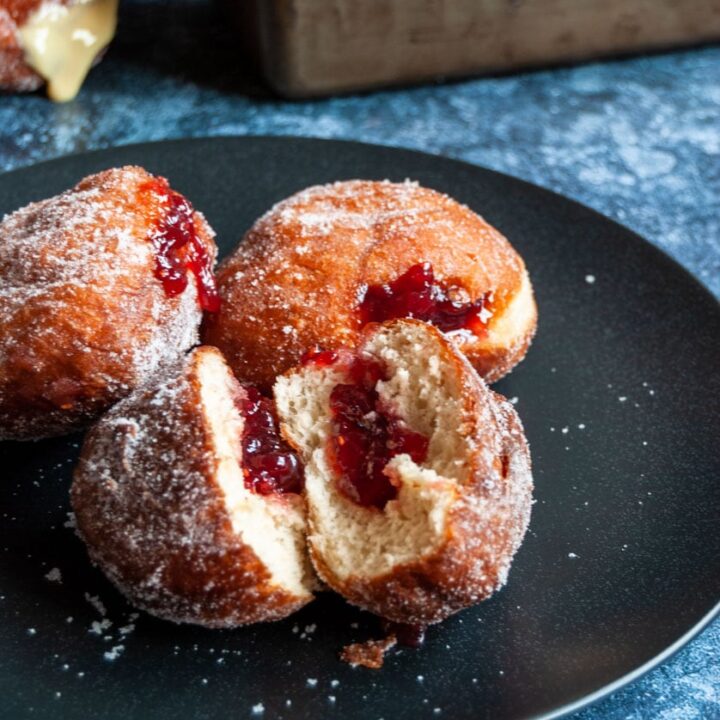
Homemade Doughnuts
Who needs to buy doughnuts when you can make them yourself? This recipe for homemade doughuts is the BEST! Made them for your family and friends and they will swoon!
Ingredients
- 150ml whole milk
- 100ml freshly boiled water from a kettle
- 500g strong white bread flour
- 14g fast action instant yeast
- 1 Teaspoon fine salt
- 2 medium eggs, at room temperature
- 1 teaspoon vanilla extract (not essence)
- 55g caster sugar
- 60g soft butter
- Approximately 1.5 litres Vegetable or Sunflower for frying
- 180g caster sugar to coat the cooked doughnuts
- FOR FILLED DOUGHNUTS:
- Approx 200g your choice of jam, custard or lemon curd
- FOR GLAZED DOUGHNUTS:
- 200g icing sugar
- 1 teaspoon vanilla extract
- 3 tablespoons milk
- FOR STRAWBERRIES AND CREAM DOUGHNUTS:
- 300ml double cream
- 1/2 teaspoon vanillla extract
- 1/2 tablespoon icing sugar
- 180g fresh strawberries, hulled and sliced
- Bottle of shop bought strawberry sauce, for drizzling
- CINNAMON SUGAR:
- 1 tablespoon caster sugar
- 1 teaspoon ground cinnamon
Instructions
- Pour the milk into a measuring jug and pour over the freshly boiled water.
- Place the flour, yeast, salt and sugar in a large bowl, placing the yeast and salt at opposite sides of the bowl. Give everything a brief mix together, make a well in the centre and crack in the eggs, followed by the vanilla extract and about two thirds of the milk and water. Start to mix everything together, adding more of the liquid until you have a soft, slightly sticky dough. I mix my freestanding mixer for this job - it can be done by hand but it takes some muscle work! Gradually add the soft butter, a spoonful at a time.
- If using a stand mixer, knead for about 5 minutes. If mixing by hand, it will take about 10 minutes to get past the stage where the dough is wet, sticky and possibly difficult to work with. Don't worry though - keep mixing until the dough is smooth, silky and pliable.
- Lightly oil a large bowl and place the dough inside. Cover with cling film (I use a shower cap!) and leave at room temperature for one to two hours or until doubled in size. Enriched dough with butter and sugar can take a little longer to rise, so don't be too concerned if it seems to be taking a while.
- When the dough has risen, deflate it by very lightly punching it down, then fold it over a few times. This will knock the air out so the dough is easier to work with. Lightly oil two large baking trays. Divide the dough into small pieces (about 50g each is the ideal size.)
- Very lightly oil a work surface. Many recipes tell you to flour the surface, but I generally find it easier to use a little oil. Cradle each piece of dough in your hand and gently roll it on the work surface, applying light pressure until you have a smooth, tight ball of dough.
- Place them on the prepared baking sheets, spacing them well apart to allow for spreading. Cover them loosely with cling film or large proving bags and leave for 40-60 minutes or until almost doubled in size. Please see the notes section below for instructions on how to make finger doughnuts, doughnut holes and ring doughnuts.
- When the doughnuts have almost doubled in size, heat the oil to 160C/320F. Make sure the temperature does not go any higher or the doughnuts will cook too quickly on the outside before they are cooked through on the inside. If the heat drops below 150C, the doughnuts will be greasy and stodgy. Obviously it's much easier to control the heat using a deep fat fryer. If using a large saucepan, a sugar thermometer is crucial.
- As gently as possible, lift the doughnuts one at a time from the tray and gently place in the fryer, trying not to deflate the doughnuts too much. I use a lightly oiled palette knife to do this. Fry the doughnuts two at a time for 2-3 minutes each side (3-4 minutes if making finger doughnuts.) They should puff up and turn light golden.
- Remove from the fryer with a slotted spoon and drain on kitchen towels for a few minutes before rolling the hot doughnuts in the caster sugar. Place the doughnuts on a wire rack to cool completely before filling.
- To make filled doughnuts, I use a piping bag fitted with a round nozzle with a diameter of about 1 inch. Make a little hole in the side of the cooled doughnut, insert the nozzle and fill with your chosen filling until it oozes out the top. You should aim to get about 2 tablespoons worth of jam or custard in each doughnut - be generous!
- To make the filling for the strawberries and cream finger doughnuts, lightly whip the double cream with the icing sugar and vanilla extract until you have soft peaks. Place the cream in a piping bag fitted with a 1 inch nozzle. Split open the cold doughnut, pipe on the cream and top the cream with the sliced strawberries. Drizzle over the strawberry sauce. Keep chilled until ready to serve.
- To make the vanilla glaze, stir together the icing sugar, vanilla extract and milk until you have a glaze that is neither too thick and not too thin. You might need to add a little more milk to get the right consistency. I like to dip the still slightly warm doughnuts in glaze just once for a thin coating, but you could double dip them if you want a thicker coating.
Notes
HOW TO MAKE RING (GLAZED) DOUGHNUTS
Flour a work surface and using a rolling pin, roll out the dough into a large round approximately the thickness of two one pound coins. Using a 4 inch round floured cutter, cut out rounds of dough. I keep a bowl of flour beside me and dip the cutter in it each time I cut out a round - it helps prevent the dough from sticking to the cutter.
Using a 1 1/2 inch round straight edged cutter, cut out the middle of each round but don’t discard them.
Place the rounds of dough on two large oiled baking trays, leaving plenty space between them because they will double in size. Place the holes on a smaller oiled tray.
Cover the trays with oiled cling film or large proving bags and leave to prove for 40 minutes to an hour, or until doubled in size.
Fry the doughnuts for 2-3 minutes per side or until light golden and puffed up. Drain on kitchen paper for a few minutes before lightly coating in caster sugar. Place on a wire rack to cool completely before filling.
HOW TO MAKE FINGER DOUGHNUTS
For finger doughnuts, roll the dough into balls then roll them into long finger shapes, about 7 inches long. They will probably shrink back slightly, but don’t worry too much about it.
Place on two or three large oiled baking trays, leaving some space between them to allow for spreading. Cover the trays with oiled cling film or large proving bags and leave for 40 minutes to an hour or until doubled in size.
Fry the doughnuts for 3-4 minutes on each side, drain on kitchen paper and dip in caster sugar while still hot. Place on a wire rack to cool completely before filling with cream.
HOW TO MAKE DOUGHNUT HOLES
Prove the doughnut holes on an oiled baking tray. Fry the holes for about 2 minutes per side (see recipe card for full instructions), drain on kitchen towel for a few minutes before tossing in cinnamon sugar or dipping in vanilla glaze.
Nutrition Information:
Yield: 18 Serving Size: 1Amount Per Serving: Calories: 461Total Fat: 15gSaturated Fat: 9gTrans Fat: 0gUnsaturated Fat: 5gCholesterol: 73mgSodium: 232mgCarbohydrates: 75gFiber: 4gSugar: 43gProtein: 8g
Calories and nutritional information are provided by a third party application and should be viewed as indicative figures only.
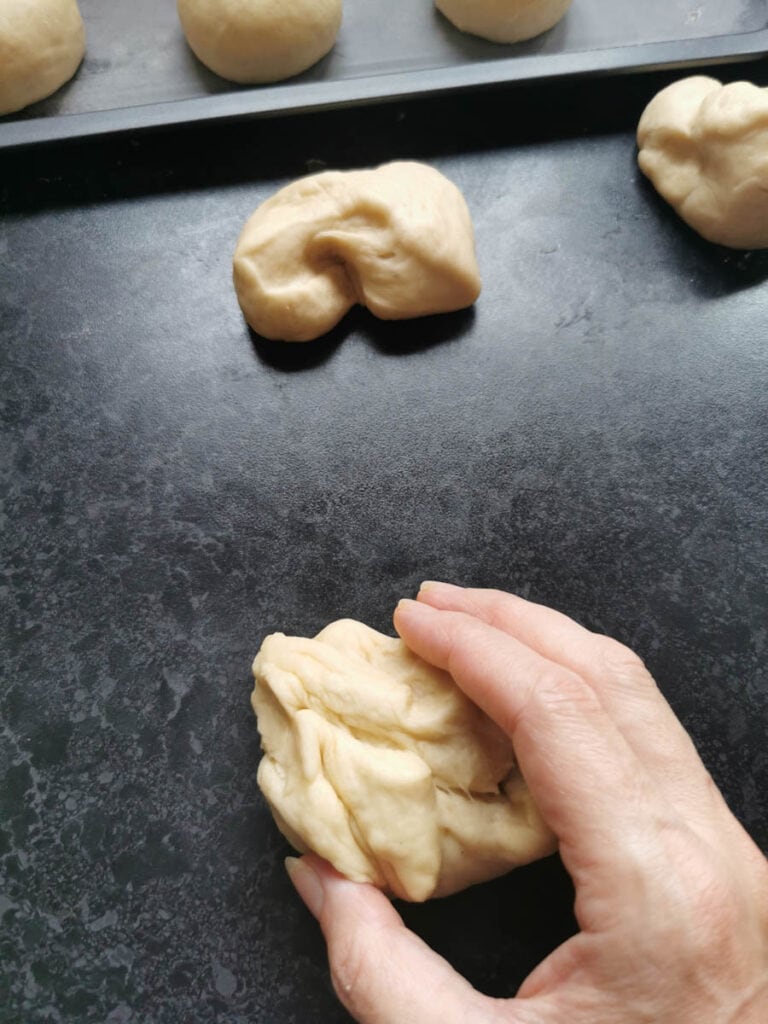
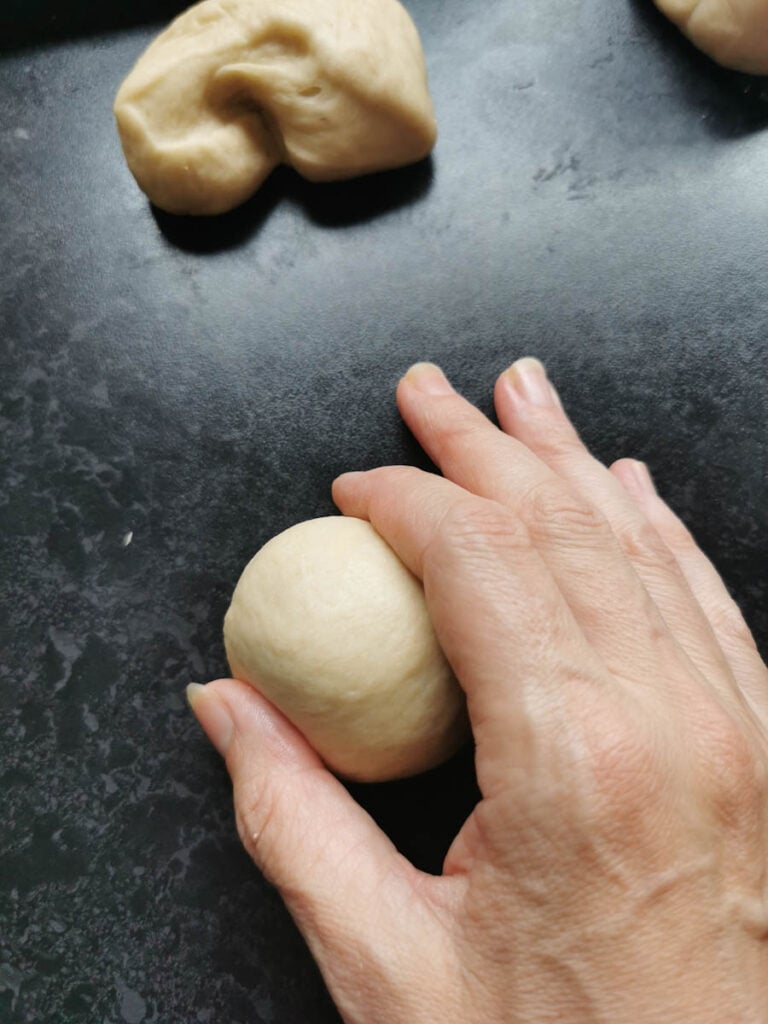

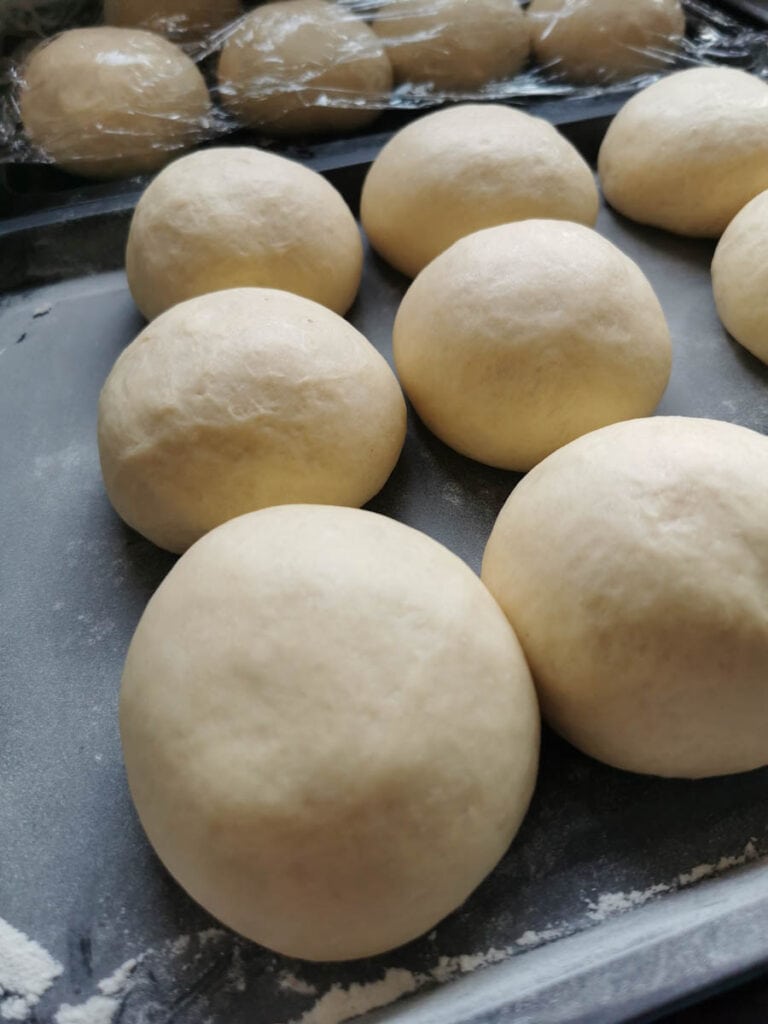
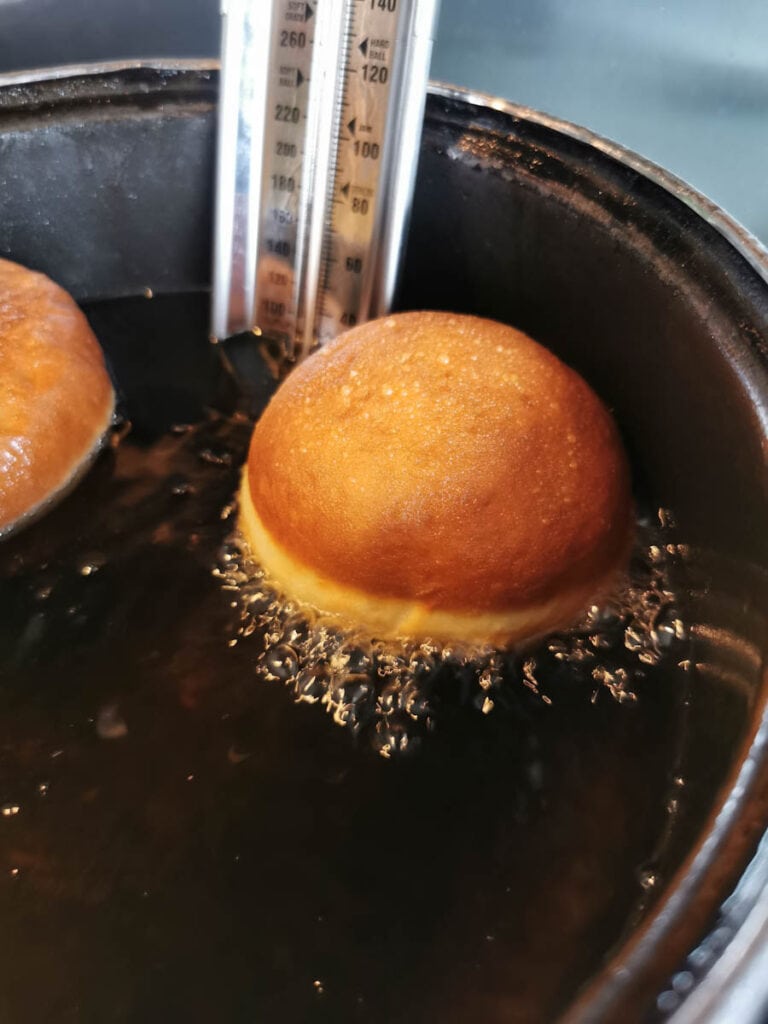
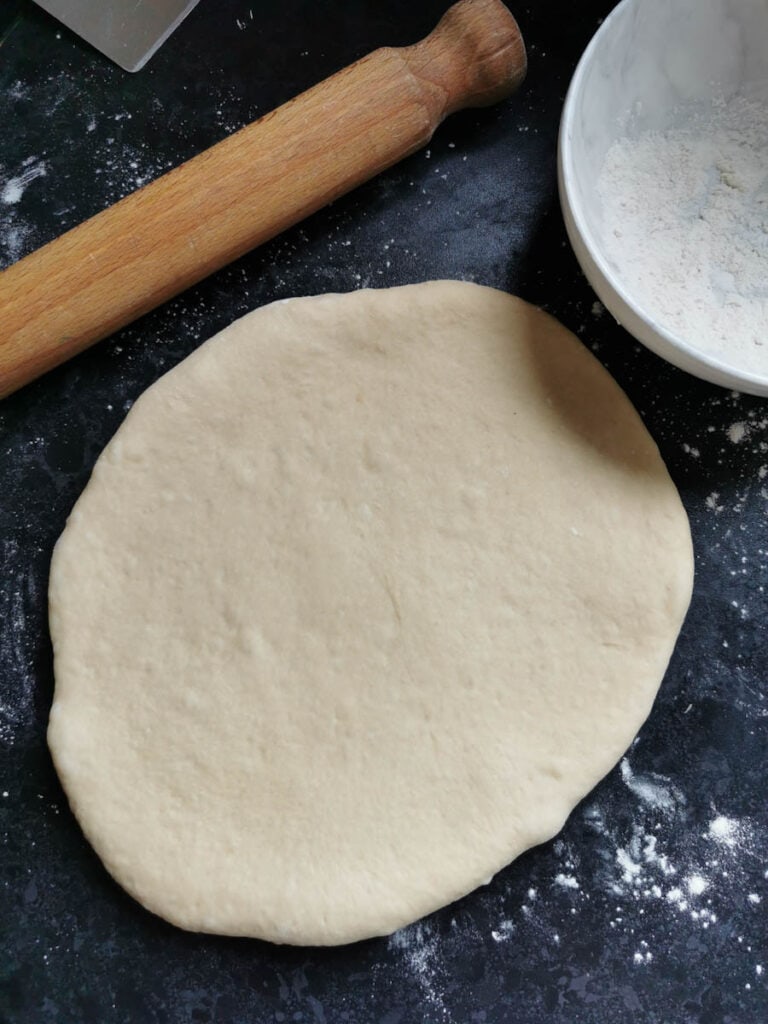
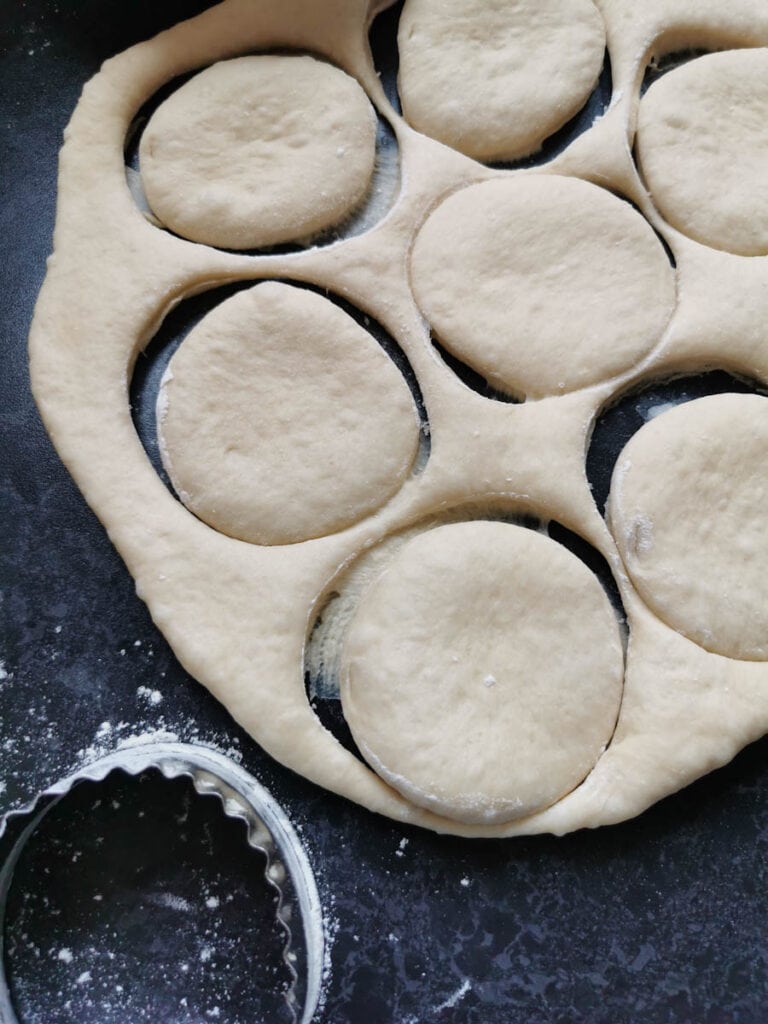
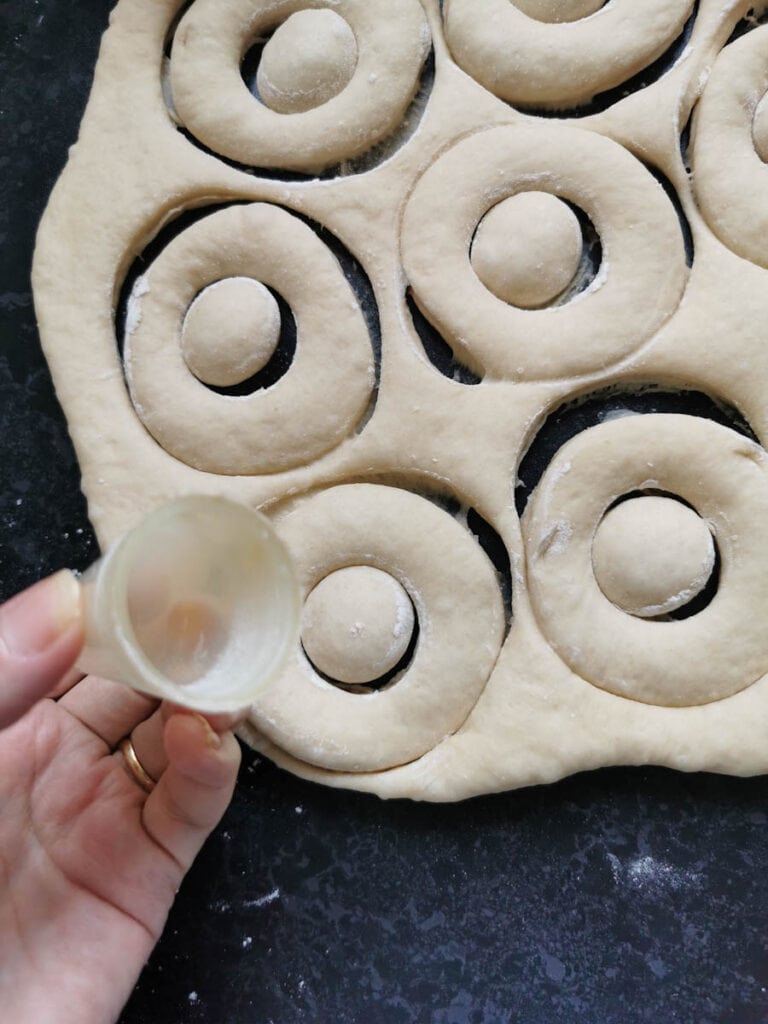

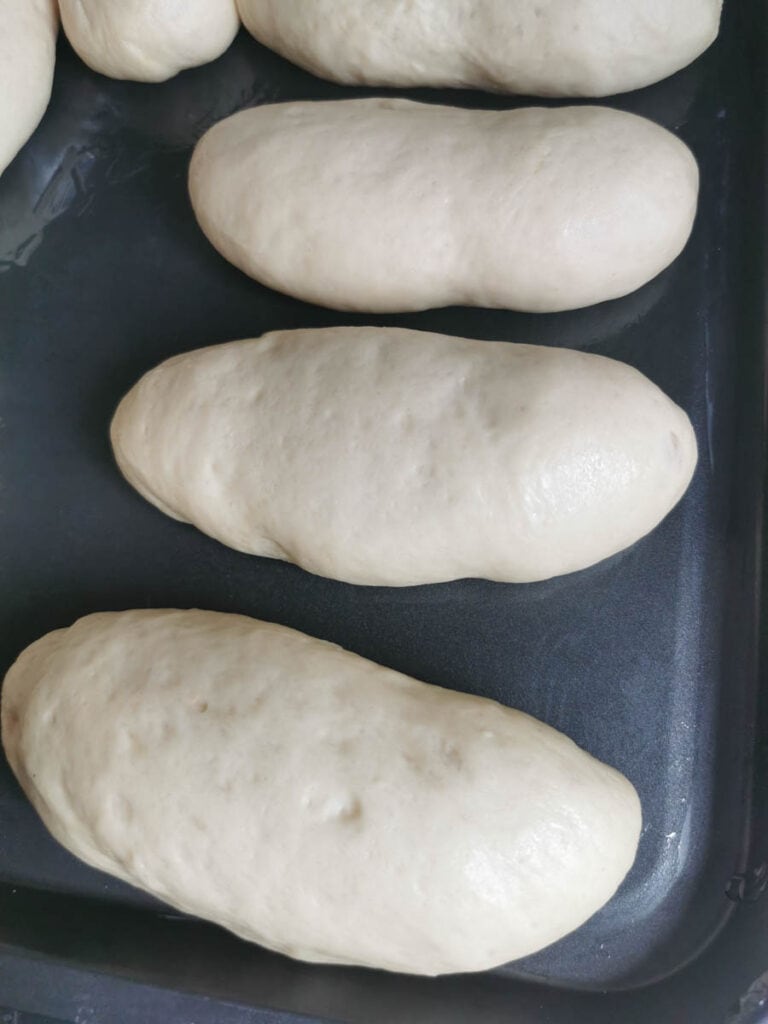
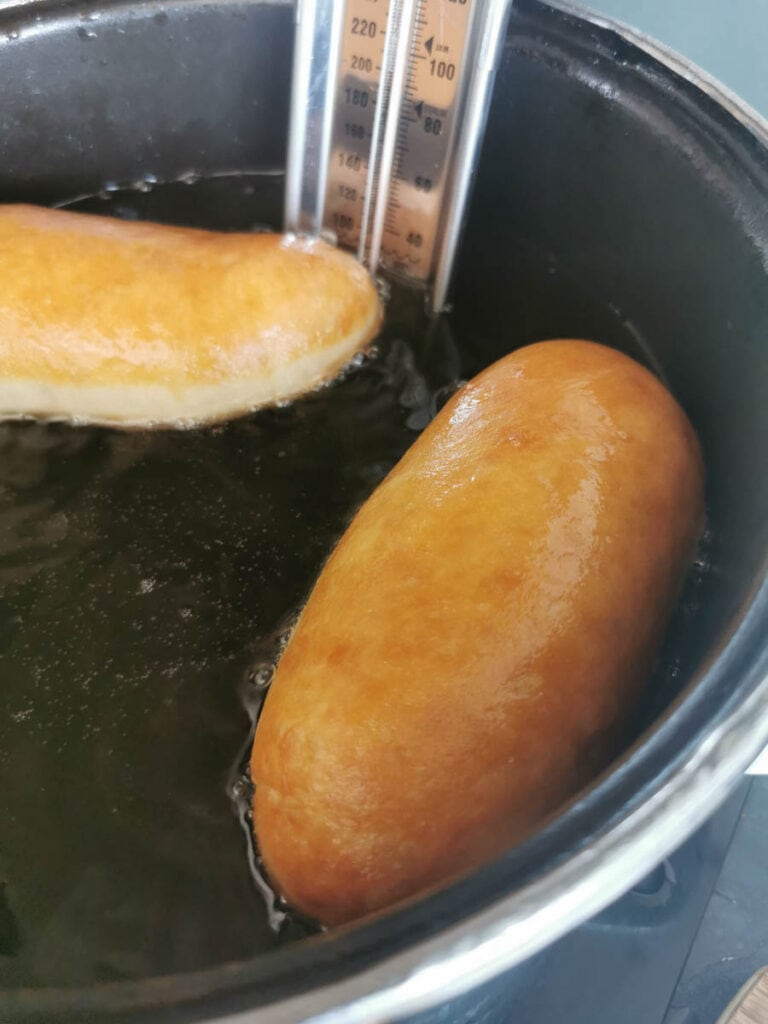

Could you freeze these?
Hi Paul I’ve never done it myself, but yes they can be frozen. Here’s a handy link to all the information you’ll need: https://www.freezeit.co.uk/can-you-freeze-doughnuts/